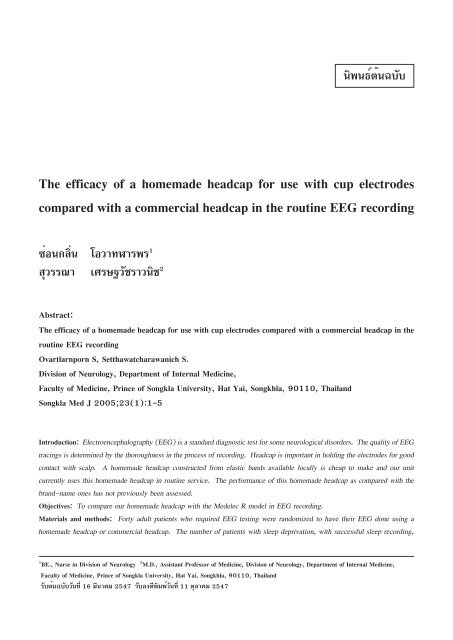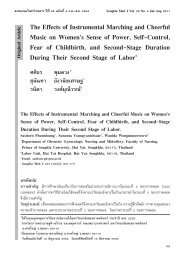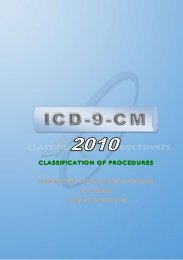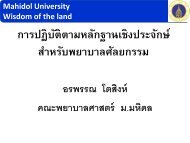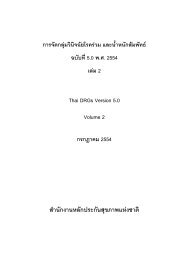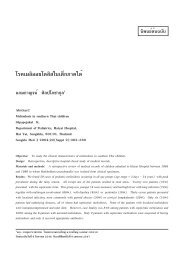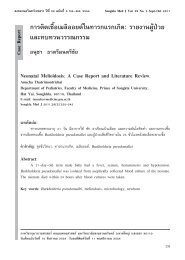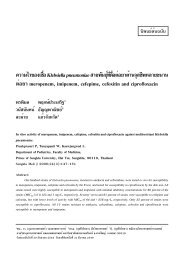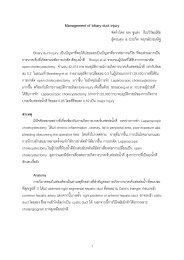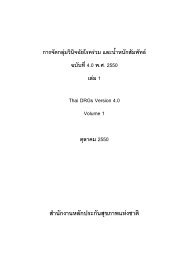The efficacy of a homemade headcap for use with cup electrodes ...
The efficacy of a homemade headcap for use with cup electrodes ...
The efficacy of a homemade headcap for use with cup electrodes ...
You also want an ePaper? Increase the reach of your titles
YUMPU automatically turns print PDFs into web optimized ePapers that Google loves.
<strong>The</strong> <strong>efficacy</strong> <strong>of</strong> a <strong>homemade</strong> <strong>headcap</strong> <strong>for</strong> <strong>use</strong> <strong>with</strong> <strong>cup</strong> <strong>electrodes</strong><br />
compared <strong>with</strong> a commercial <strong>headcap</strong> in the routine EEG recording<br />
ซ่อนกลิ่น<br />
โอวาทฬารพร1 สุวรรณา เศรษฐวัชราวนิช2 นิพนธ์ต้นฉบับ<br />
Abstract:<br />
<strong>The</strong> <strong>efficacy</strong> <strong>of</strong> a <strong>homemade</strong> <strong>headcap</strong> <strong>for</strong> <strong>use</strong> <strong>with</strong> <strong>cup</strong> <strong>electrodes</strong> compared <strong>with</strong> a commercial <strong>headcap</strong> in the<br />
routine EEG recording<br />
Ovartlarnporn S, Setthawatcharawanich S.<br />
Division <strong>of</strong> Neurology, Department <strong>of</strong> Internal Medicine,<br />
Faculty <strong>of</strong> Medicine, Prince <strong>of</strong> Songkla University, Hat Yai, Songkhla, 90110, Thailand<br />
Songkla Med J 2005;23(1):1-5<br />
Introduction: Electroencephalography (EEG) is a standard diagnostic test <strong>for</strong> some neurological disorders. <strong>The</strong> quality <strong>of</strong> EEG<br />
tracings is determined by the thoroughness in the process <strong>of</strong> recording. Headcap is important in holding the <strong>electrodes</strong> <strong>for</strong> good<br />
contact <strong>with</strong> scalp. A <strong>homemade</strong> <strong>headcap</strong> constructed from elastic bands available locally is cheap to make and our unit<br />
currently <strong>use</strong>s this <strong>homemade</strong> <strong>headcap</strong> in routine service. <strong>The</strong> per<strong>for</strong>mance <strong>of</strong> this <strong>homemade</strong> <strong>headcap</strong> as compared <strong>with</strong> the<br />
brand-name ones has not previously been assessed.<br />
Objectives: To compare our <strong>homemade</strong> <strong>headcap</strong> <strong>with</strong> the Medelec R model in EEG recording.<br />
Materials and methods: Forty adult patients who required EEG testing were randomized to have their EEG done using a<br />
<strong>homemade</strong> <strong>headcap</strong> or commercial <strong>headcap</strong>. <strong>The</strong> number <strong>of</strong> patients <strong>with</strong> sleep deprivation, <strong>with</strong> successful sleep recording,<br />
1 BE., Nurse in Division <strong>of</strong> Neurology 2 M.D., Assistant Pr<strong>of</strong>essor <strong>of</strong> Medicine, Division <strong>of</strong> Neurology, Department <strong>of</strong> Internal Medicine,<br />
Faculty <strong>of</strong> Medicine, Prince <strong>of</strong> Songkla University, Hat Yai, Songkhla, 90110, Thailand<br />
รับต้นฉบับวันที่ 16 มีนาคม 2547 รับลงตีพิมพ์วันที่ 11 ตุลาคม 2547
สงขลานครินทร์เวชสาร สายครอบศีรษะที ่ประกอบเองในการตรวจ EEG<br />
2<br />
ปีที่ 23 ฉบับที่ 1 ม.ค.-ก.พ. 2005 ซ่อนกลิ่น โอวาทฬารพร, สุวรรณา เศรษฐวัชราวนิช<br />
patients' cooperation, number <strong>of</strong> electrode movement and popping were noted. <strong>The</strong> tracings were interpreted blindly and the<br />
number <strong>of</strong> artifacts due to electrode movement or popping was recorded.<br />
Results: Forty patients were recruited, 20 in <strong>homemade</strong> <strong>headcap</strong> (group A) and 20 in Medelec R model <strong>headcap</strong> (group B).<br />
<strong>The</strong> demographic data, number <strong>with</strong> sleep deprivation, level <strong>of</strong> cooperation and successful sleep EEG recording were not<br />
different between the two groups. <strong>The</strong> number <strong>of</strong> abnormal EEG was higher in group A than in group B. (p=0.034) <strong>The</strong>re<br />
were no artifacts due to electrode movement or popping in either group. <strong>The</strong> electrode movement was significantly less in group<br />
A than in group B during intermittent photic stimulation. <strong>The</strong> electrode popping during hyperventilation recording was higher<br />
in group A than in group B.<br />
Conclusion: Our study showed that the per<strong>for</strong>mance <strong>of</strong> our <strong>homemade</strong> <strong>headcap</strong> was comparable to that <strong>of</strong> Medelec R model.<br />
<strong>The</strong> number <strong>of</strong> electrode movement and popping were similar <strong>with</strong> the two <strong>headcap</strong>s and no artifacts due to these phenomena<br />
were detected. <strong>The</strong> cost <strong>of</strong> our <strong>homemade</strong> <strong>headcap</strong> is low <strong>with</strong> a durability <strong>of</strong> 6 months and it can be made anywhere. It is<br />
there<strong>for</strong>e suitable in any region <strong>with</strong> economic constraint.<br />
Key words: <strong>homemade</strong> <strong>headcap</strong> <strong>for</strong> EEG recording<br />
บทคัดย่อ:<br />
บทนำ: การตรวจบันทึกคลื ่นไฟฟ้าสมอง (EEG) เป็นการตรวจมาตรฐานสำหรับโรคระบบประสาทวิทยา คุณภาพของการตรวจบันทึก<br />
คลื ่นไฟฟ้าสมองขึ ้นกับความพิถีพิถันในการบันทึก สายครอบศีรษะเป็นสิ ่งสำคัญในการยึดขั ้วไฟฟ้าให้ติดแน่นกับหนังศีรษะ สายครอบ<br />
ศีรษะที ่ทำจากสายยางราคาถูกซึ ่งสามารถหาได้ง่ายและได้นำมาใช้ในการให้บริการการตรวจบันทึกคลื ่นไฟฟ้าสมองของหน่วยประสาทวิทยา<br />
ในปัจจุบัน การเปรียบเทียบประสิทธิภาพของสายครอบศีรษะที ่ประกอบขึ ้นเองกับสายครอบศีรษะที ่ผลิตสำเร็จยังไม่มีการศึกษามาก่อน<br />
วัตถุประสงค์: เพื่อเปรียบเทียบประสิทธิภาพสายครอบศีรษะที่ประกอบขึ้นเองกับสายครอบศีรษะสำเร็จรูปแบบหนึ่งของ Medelec<br />
ในการตรวจบันทึกคลื ่นไฟฟ้าสมอง<br />
วัสดุและวิธีการ: ผู ้ป่วยผู ้ใหญ่จำนวน 40 ราย ที ่ต้องตรวจบันทึกคลื ่นไฟฟ้าสมอง ได้รับการตรวจโดยใช้สายครอบศีรษะที ่ประกอบขึ ้นเอง<br />
หรือสายครอบศีรษะสำเร็จรูป โดยการสุ ่มทางสถิติและทำการบันทึกจำนวนของผู ้ป่วยที ่อดนอนมาก่อนตรวจ ความสำเร็จในการตรวจ<br />
บันทึกคลื่นไฟฟ้าสมองในขณะที่ผู้ป่วยหลับ ความร่วมมือของผู้ป่วย จำนวนครั้งของการเกิดขั้วไฟฟ้าขยับเขยื้อน จำนวนครั้งของ<br />
การเลื่อนหลุดของขั้วไฟฟ้า การแปลผลการตรวจบันทึกคลื่นไฟฟ้าสมองโดยผู้อ่านไม่ทราบว่าใช้สายครอบศีรษะชนิดใดและมีการนับ<br />
จำนวนครั ้งของสัญญาณไฟฟ้ารบกวนที ่เกิดจากการขยับเขยื ้อนหรือเลื ่อนหลุดของขั ้วไฟฟ้า<br />
ผลการศึกษา: ผู้ป่วย 20 รายใช้สายครอบศีรษะที่ประกอบขึ้นเอง (กลุ่ม A) และ 20 รายใช้สายครอบศีรษะสำเร็จรูป (กลุ่ม B)<br />
ข้อมูลเกี่ยวกับผู้ป่วย จำนวนผู้ป่วยที่อดนอนก่อนทำการตรวจ ระดับความร่วมมือและการบันทึกขณะผู้ป่วยหลับ พบว่าไม่มีความ<br />
แตกต่างกันในสองกลุ ่ม ผลการตรวจพบความผิดปกติของคลื ่นไฟฟ้าสมองในกลุ ่ม A สูงกว่าในกลุ ่ม B (p = 0.034) ไม่พบสัญญาณไฟฟ้า<br />
รบกวนที ่เกิดจากการขยับเขยื ้อนหรือเลื ่อนหลุดของขั ้วไฟฟ้าในทั ้งสองกลุ ่ม ในกลุ ่ม A พบการขยับเขยื ้อนของขั ้วไฟฟ้าน้อยกว่าในกลุ ่ม<br />
B อย่างมีนัยสำคัญระหว่างที ่ทำการกระตุ ้นผู ้ป่วยโดยการใช้แสงกระพริบเปิดและปิดเป็นจังหวะ ขณะที ่ทำการตรวจบันทึกโดยการกระตุ ้น<br />
ให้ผู ้ป่วยหายใจแรงลึกพบขั ้วไฟฟ้ากระตุกในกลุ ่ม A มากกว่ากลุ ่ม B<br />
สรุป: การศึกษาในครั้งนี้พบว่าประสิทธิภาพของการใช้สายครอบศีรษะที่ประกอบขึ้นเองเมื่อเปรียบเทียบกับการใช้สายครอบศีรษะ<br />
สำเร็จรูปไม่มีความแตกต่างกัน จำนวนครั ้งของการเกิดการขยับเขยื ้อนหรือเลื ่อนหลุดของขั ้วไฟฟ้าใกล้เคียงกันในทั ้งสองกลุ ่มและไม่พบ<br />
สัญญาณไฟฟ้ารบกวน ราคาของสายครอบศีรษะที ่ประกอบขึ ้นเองมีราคาถูกและมีระยะการใช้งานได้ประมาณ 6 เดือน จึงเหมาะสมที ่จะนำ<br />
มาใช้ในที ่ซึ ่งมีข้อจำกัดทางเศรษฐกิจ<br />
คำสำคัญ: สายครอบศีรษะที ่ประกอบเองในการตรวจ EEG
Songkla Med J Homemade <strong>headcap</strong> <strong>for</strong> EEG recording<br />
Vol. 23 No. 1 Jan.-Feb. 2005 3<br />
Ovartlarnporn S, Setthawatcharawanich S.<br />
Introduction<br />
Electroencephalography (EEG) is a standard diagnostic<br />
test <strong>for</strong> various neurological disorders. <strong>The</strong> quality <strong>of</strong> EEG<br />
tracings is determined by the thoroughness in the process <strong>of</strong><br />
recording. <strong>The</strong> factors involved in this process include hair<br />
shampooing to get rid <strong>of</strong> oily scalp and hair, precise placement<br />
<strong>of</strong> <strong>electrodes</strong> and good contact between the <strong>electrodes</strong><br />
and scalp. To obtain good contact, skin preparation at the<br />
sites <strong>of</strong> electrode placement, application <strong>of</strong> EEG paste and<br />
<strong>headcap</strong> are important. <strong>The</strong> <strong>headcap</strong> <strong>for</strong> EEG recording<br />
prevents the <strong>electrodes</strong> from movement and popping that<br />
markedly influences the quality <strong>of</strong> EEG tracings by inducing<br />
artifacts leading to difficult EEG interpretation. Currently,<br />
there are many brands <strong>of</strong> commercial <strong>headcap</strong>s available on<br />
the market; however, the cost <strong>of</strong> these <strong>headcap</strong>s is rather high.<br />
A <strong>homemade</strong> <strong>headcap</strong> constructed by elastic bands available<br />
locally is cheap to make and our unit currently <strong>use</strong>s this <strong>homemade</strong><br />
<strong>headcap</strong> in routine service. 1 <strong>The</strong> per<strong>for</strong>mance <strong>of</strong> this<br />
<strong>homemade</strong> <strong>headcap</strong> as compared <strong>with</strong> the brand-name ones<br />
has not previously been assessed.<br />
Objectives<br />
<strong>The</strong> objective <strong>of</strong> this study was to compare our <strong>homemade</strong><br />
<strong>headcap</strong> <strong>with</strong> one Medelec R model in EEG recording in<br />
terms <strong>of</strong> tracing quality regarding the number <strong>of</strong> artifacts due<br />
to electrode movement and popping.<br />
Materials and methods<br />
Forty adult patients who required EEG testing from<br />
July 2000 till January 2001 were randomized to have their<br />
EEG done using <strong>homemade</strong> <strong>headcap</strong> or commercial <strong>headcap</strong>.<br />
(Figure 1, the details <strong>of</strong> the <strong>homemade</strong> <strong>headcap</strong> construction<br />
need many illustrations to be described, so anyone who is<br />
interested please contact the first author). All the patients<br />
were requested to shampoo their hair and refrain from using<br />
any sprays or oils 2 as well as having sleep deprivation the<br />
night prior to the date <strong>of</strong> their EEG recording. 3 <strong>The</strong> EEG<br />
recording was done <strong>with</strong> the patient awake, <strong>with</strong> hyperventilation,<br />
post hyperventilation, <strong>with</strong> intermittent photic<br />
stimulation and during sleep (in patients who could sleep<br />
during the EEG recording). All the records were per<strong>for</strong>med<br />
<strong>with</strong> the Medelec R DG32 machine and <strong>cup</strong> <strong>electrodes</strong>. <strong>The</strong><br />
placement <strong>of</strong> the 21 <strong>electrodes</strong> was done according to the<br />
standard International 10-20 system as recommended by the<br />
American EEG Society. 4<br />
<strong>The</strong> number <strong>of</strong> patients <strong>with</strong> sleep deprivation as<br />
requested prior to recording, number <strong>with</strong> successful sleep<br />
recording, patients' cooperation during the recording, number<br />
<strong>of</strong> electrode movements (EM) and number <strong>of</strong> electrode<br />
popping (EP) in each recording interval were noted.<br />
<strong>The</strong> tracings were interpreted by one <strong>of</strong> the authors<br />
(SS) who was blinded to the type <strong>of</strong> <strong>headcap</strong> <strong>use</strong>d to per<strong>for</strong>m<br />
the tracings. <strong>The</strong> numbers <strong>of</strong> artifacts due to EM or EP in the<br />
overall recording period and in each interval were recorded.<br />
Figure 1 <strong>The</strong> <strong>homemade</strong> <strong>headcap</strong> (left) and commercial <strong>headcap</strong> (right) <strong>use</strong>d in this study
สงขลานครินทร์เวชสาร สายครอบศีรษะที ่ประกอบเองในการตรวจ EEG<br />
4<br />
ปีที่ 23 ฉบับที่ 1 ม.ค.-ก.พ. 2005 ซ่อนกลิ่น โอวาทฬารพร, สุวรรณา เศรษฐวัชราวนิช<br />
Twenty subjects in each group were arbitrarily chosen<br />
since there are no data regarding this type <strong>of</strong> comparative<br />
study available.<br />
Student T-test and chi-square test were employed <strong>for</strong><br />
statistical analysis where appropriate.<br />
Results<br />
Forty patients, 23 female and 17 male, were recruited<br />
and completed the study. Twenty had EEG recording <strong>with</strong> the<br />
<strong>homemade</strong> <strong>headcap</strong> (group A) and the other 20 were done<br />
<strong>with</strong> the Medelec R model <strong>headcap</strong> (group B). <strong>The</strong> mean age<br />
<strong>of</strong> the two groups, the male to female ratio, the number <strong>of</strong><br />
patients <strong>with</strong> sleep deprivation, the proportion <strong>of</strong> patients <strong>with</strong><br />
good and fair cooperation and successful sleep EEG recording<br />
were not different between the two groups (Table 1). <strong>The</strong><br />
number <strong>of</strong> EEG tracings showing abnormal results was higher<br />
in group A than in group B (p=0.034). <strong>The</strong>re were no<br />
artifacts due to EM or EP in either group.<br />
<strong>The</strong> number <strong>of</strong> EM was significantly less in group A<br />
than in group B during intermittent photic stimulation<br />
recording but in all other intervals there was no significant<br />
difference between the 2 groups (Table 2). <strong>The</strong> number <strong>of</strong><br />
EP during hyperventilation recording was higher in group A<br />
than in group B and this was marginally statistically significant.<br />
However, the number <strong>of</strong> EP in all other recording intervals<br />
and the total EEG recording time were not significantly<br />
different between the two groups (Table 2).<br />
Table 1 <strong>The</strong> mean age, sex and numbers <strong>with</strong> sleep deprivation, cooperation, successful sleep EEG recording and results <strong>of</strong><br />
EEG tracings <strong>of</strong> the two groups<br />
Group A Group B Remarks<br />
Mean age ± SD 29.25 ± 13.87 26.50 ± 10.58 ns<br />
Male : female 10:10 7:13 ns<br />
Number <strong>with</strong><br />
sleep deprivation 14 18 ns<br />
good : fair cooperation 15:5 16:4 ns<br />
successful sleep EEG record 15 17 ns<br />
normal : abnormal EEG tracings 11:9 14:6 p = 0.034<br />
ns = statistically not significant<br />
Table 2 <strong>The</strong> number <strong>of</strong> EM and EP during each EEG recording interval and total time <strong>of</strong> EEG recording between the<br />
2 groups<br />
Group A Group B Remarks 95% CI<br />
Electrode movements mean ± SD mean ± SD<br />
Awake recording 8.7 ± 6.51 9.5 ± 5.24 ns -4.58-2.98<br />
Hyperventilation recording 4.6 ± 3.41 4.80 ± 3.69 ns -2.47-2.07<br />
Post hyperventilation recording 1.9 ± 2.97 2.95 ± 2.46 ns -2.79-0.69<br />
Intermittent photic stimulation recording 2.0 ± 2.60 3.55 ± 2.09 p = 0.045 -3.05-0.04<br />
Sleep recording 3.5 ± 4.33 6.3 ± 6.60 ns -6.37-0.77
Songkla Med J Homemade <strong>headcap</strong> <strong>for</strong> EEG recording<br />
Vol. 23 No. 1 Jan.-Feb. 2005 5<br />
Ovartlarnporn S, Setthawatcharawanich S.<br />
Table 2 (continued)<br />
Discussion<br />
Our study showed that the per<strong>for</strong>mance <strong>of</strong> our <strong>homemade</strong><br />
<strong>headcap</strong> was comparable to that <strong>of</strong> the Medelec R<br />
model. <strong>The</strong> number <strong>of</strong> EM and EP were similar <strong>with</strong> both<br />
<strong>headcap</strong>s and no artifacts due to these phenomena were<br />
detected. <strong>The</strong> <strong>homemade</strong> <strong>headcap</strong> produced less EM during<br />
the intermittent photic stimulation procedure than the Medelec<br />
R model. Since the intermittent photic stimulation procedure<br />
was done at the last period <strong>of</strong> awake EEG recording, the EM<br />
may be more likely to occur due to the patient's decreased<br />
level <strong>of</strong> cooperation beca<strong>use</strong> <strong>of</strong> fatigue or discom<strong>for</strong>t from the<br />
prolonged recording. <strong>The</strong> less frequent EM in the <strong>homemade</strong><br />
<strong>headcap</strong> may signify that it holds the <strong>electrodes</strong> more firmly<br />
than the Medelec R model. EP during hyperventilation<br />
recording was higher in the <strong>homemade</strong> <strong>headcap</strong> <strong>with</strong> marginal<br />
statistical significance. However, the number <strong>of</strong> the patients<br />
in this study was small so further study <strong>with</strong> a larger number<br />
<strong>of</strong> patients is mandatory be<strong>for</strong>e any conclusion regarding these<br />
points can be drawn. <strong>The</strong> cost <strong>of</strong> our <strong>homemade</strong> <strong>headcap</strong> is<br />
about 150 baht and it can be <strong>use</strong>d <strong>for</strong> approximately 6 months.<br />
This is much cheaper than the commercial one. We believe<br />
that our <strong>headcap</strong>, which can be made anywhere, is cost effective<br />
particularly in the regions where cost is the important<br />
issue.<br />
Group A Group B Remarks 95% CI<br />
Electrode popping mean ± SD mean ± SD<br />
Awake recording 0.45 ± 0.83 0.50 ± 1.47 ns -0.81-0.71<br />
Hyperventilation recording 0.65 ± 1.04 0.15 ± 0.37 p = 0.05 0.001-0.99<br />
Post hyperventilation recording 0.55 ± 1.10 0.45 ± 1.00 ns -0.57-0.77<br />
Intermittent Photic stimulation recording 0.10 ± 0.45 0.05 ± 0.22 ns -0.17-0.27<br />
Sleep recording 0.30 ± 0.66 0.50 ± 1.24 ns -0.83-0.43<br />
Total recording time (hour) 2.0 ±<br />
±<br />
± .00 1.95 ± 0.22 ns -0.51-0.15<br />
Conclusion<br />
Our study showed that the per<strong>for</strong>mance <strong>of</strong> our <strong>homemade</strong><br />
<strong>headcap</strong> was comparable to that <strong>of</strong> Medelec R model.<br />
<strong>The</strong> number <strong>of</strong> EM and EP were similar <strong>with</strong> both <strong>headcap</strong>s<br />
and no artifacts due to these phenomena were detected. <strong>The</strong><br />
cost <strong>of</strong> our <strong>homemade</strong> <strong>headcap</strong> is low <strong>with</strong> durability <strong>of</strong> 6<br />
months. It can be made anywhere and is suitable in any<br />
region <strong>with</strong> cost consciousness.<br />
References<br />
1. Ovartlarnporn S. Homemade <strong>headcap</strong> <strong>for</strong> EEG scalp<br />
electrode made from inexpensive materials. Abstract<br />
presented at the annual academic meeting <strong>of</strong> the Faculty<br />
<strong>of</strong> Medicine, Prince <strong>of</strong> Songkla University. August 19-<br />
21 1998.<br />
2. Clenny SL, Johnson SM. Electrodes and their application.<br />
In Back to Basics: a Handbook <strong>of</strong> EEG Technology.<br />
Beckman Instruments; 1983;5-16.<br />
3. Niedermeyer E. Sleep and EEG. In: Niedermeyer E,<br />
Da Silva FL. editors. Electroencephalography Basic<br />
Principles, Clinical Applications, and Related Fields.<br />
3 rd ed. Philadelphia: Williams & Wilkins; 1993;153-<br />
66.<br />
4. Reilly EL. EEG recording and operation <strong>of</strong> the apparatus.<br />
In: Niedermeyer E, Da Silva FL. editors. Electroencephalography<br />
Basic Principles, Clinical Applications,<br />
and Related Fields. 3 rd ed. Philadelphia: Williams &<br />
Wilkins; 1993;104-24.


